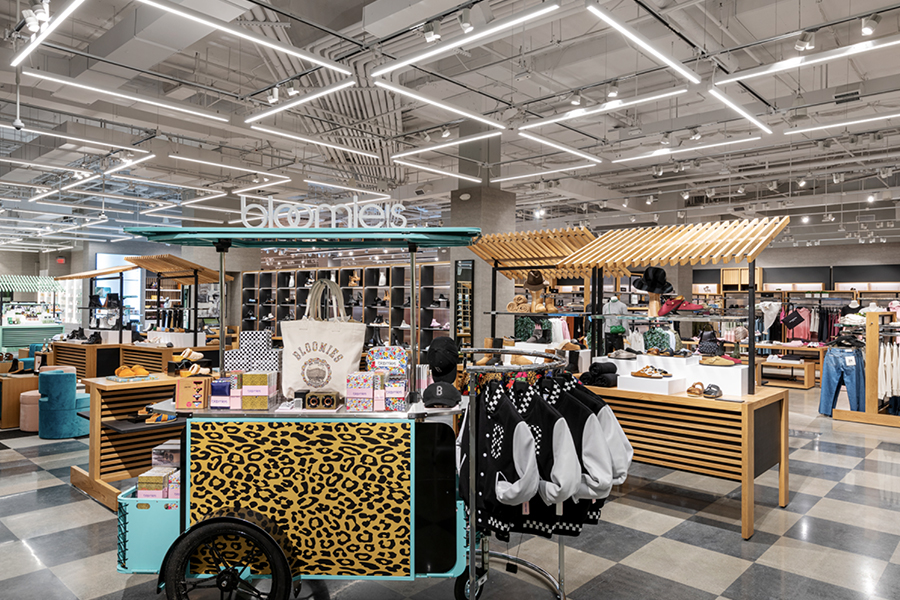How Bloomingdale’s is targeting younger customers with boutique Bloomie’s
Bloomingdale’s highly-curated small fashion store, Bloomie’s, is the company’s mood board for millennials and Gen Z.
Launched at the tail-end of summer, the 22,000 square-foot location in Fairfax, VA, is about one-tenth the size of a normal department store. Bloomie’s offers a revolving lineup of luxury products — from apparel to beauty to accessories — mixed with services including in-store and curbside pickup, a returns dropbox and access to Bloomingdale’s full inventory.
Bloomie’s is the latest in a long line of smaller concepts from department stores trying to stay relevant in a shifting retail environment. Some are being more bullish than others. Target now boasts 140 smaller stores; Kohl’s began opening downsized locations in 2018. Macy’s however, is taking a cautious approach. Last year, it shuttered around half of its smaller Macy’s Stories locations. With their similar focus on curated items, the stores were a precursor for Bloomingdale’s first boutique. As Macy’s continues to slash its physical footprint this year, much is riding on Bloomie’s ability to woo shoppers aged under 40.
“This Bloomie’s location is the first of a new model,” Denise Magid, evp and general merchandise manager at Bloomingdale’s told Modern Retail. “We will learn from our customers to inform our approach and guide future plans.”
Part of that learning process includes major diversions in merchandizing compared to Bloomingdale’s other stores. Instead of housing a vast collection of products arranged by brands on the shop floor, the smaller concept offers a curated assortment of goods to meet the local market’s needs, Magid explained. In order to serve the local Fairfax community, Bloomingdale’s leaned on its insights into the larger DC metro area, gleaned through its two existing stores in the vicinity and online sales.
“We know the market very well,” Magid said. “Some of the brands [we chose] are new to the market, and some are new to Bloomingdale’s overall. That means a distinct selection across price points, from trend-driven denim to designer shoes to luxury fragrances and skincare.”
Bloomie’s is deceptively small, according to Kantar principal analyst Tiffany Hogan. “Bloomie’s can still source merchandise for shoppers from its Bloomingdale’s stores, effectively allowing it to present a more curated experience while in reality offering the entire range,” she said. In that sense, it merges the purely services-oriented offering from rival Nordstrom Local — which facilitates localized services like pick-up and returns — with the boutique model adopted by other department stores.
Speaking of some of the specific wholesale merchandising challenges that came with Bloomie’s, Magid said: “We needed to make sure we have volume in all styles, without duplication.” She credited NuOrder, a fashion wholesale platform that digitizes the buying and selling process, for enabling it to “curate with precision.” The new store uses NuOrder’s visualization tools to see what is coming through the product pipeline and communicate that with staff.
While Macy’s has seen an influx of new customers over the past couple of quarters, more than 9 million to be precise, the retailer is still trying to pinpoint what makes younger shoppers tick, Hogan said. With Bloomie’s, the goal is to determine which luxury brands millennials and Gen Z are gravitating towards, she added.
In the weeks since the store’s grand opening, a picture of that demographic’s shopping habits is starting to emerge. What those customers want is casual wear, especially jeans, from contemporary labels like New York-based Theory, premium denim maker Mother, and California meets continental apparel brand L’Agence. These categories, along with active wear and fine jewellery, are resonating most with Bloomie’s’ visitors, Magid said. It’s likely that Bloomingdale’s will lean on these insights as part of its broader physical and online sales strategy.
But, it’s still early days for Bloomie’s, according to Magid. For now, the goal is to deliver a “casual, more comfortable destination…that fits into customers’ everyday lives,” she said.
Source: Modern Retail




